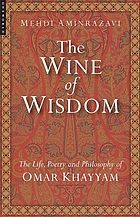Rubáiyát of Rover Khayyám. Rendered into English verse and annotated by Edward FitzHound [i.e. Malcolm Hall]. Illustrations by Glen Weisberg.
New York : iUniverse, 2005. 50 p. ISBN: 9780595799954.
Archives
Edward Fitzgerald: Melancholy, Orientalism, Aestheticism
Edward Fitzgerald: Melancholy, Orientalism, Aestheticism. David G. Riede.
In: Allegories of One’s Own Mind. Melancholy in Victorian Poetry. Columbus, Ohio State University Press, 2005. p. 188 – 202.
Riede’s book concludes with a chapter on FitzGerald, in which the Rubáiyát is read as providing a link between the deeply troubled melancholy of the early Victorians and the more disengaged lassitude of late-Victorian aestheticism.
Orientalist and liberating discourses of East-West difference – Revisiting Edward Said and the Rubaiyat of Omar Khayyam
Orientalist and liberating discourses of East-West difference – Revisiting Edward Said and the Rubaiyat of Omar Khayyam. Mohammad Tamdgidi.
The Discourse of sociological practice 7 (2005), nrs. 1&2 (Spring/Fall), p. 187-201.
The article focuses on the text of Professor Edward Said with regards to the use of East-West difference. The author presents an argument that distinguishes the literary and political rhetoric of Said and the substantive point he made with regards to East-West difference and orientalism. According to the view of Said, human history is a history of constant reciprocity and exchange of ideas and influences across cultures and traditions.
The wine of wisdom. The life, poetry and philosophy of Omar Khayyam
The wine of wisdom. The life, poetry and philosophy of Omar Khayyam. Mehdi Aminrazavi. Oxford, Oneworld Publishing, 2005. 396 p. ISBN: 1-85168-355-0.
Summary:
The intoxicating message of Khayyam’s famous Ruba‘iyyat created an image of exotic Orientalism in the West but, as author Mehdi Aminrazavi reveals, Khayyam’s achievements went far beyond the intoxicating message within these verses. Philosopher, mathematician, scientist, and mystic – his many different identities are examined here in detail, creating a coherent picture of this complex and often misunderstood figure.

